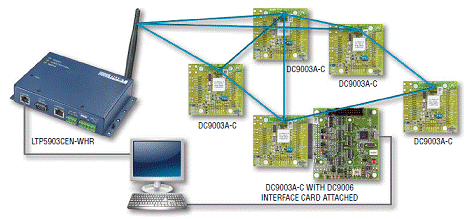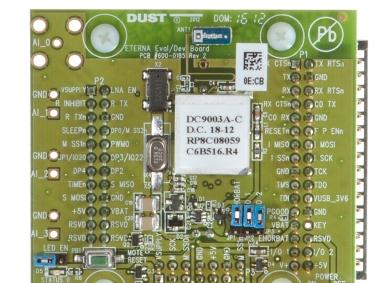基于Linear公司的LTC5800-WHM SmartMesh无线传感器网络开发方案
 112
112
 拍明
拍明
原标题:Linear LTC 5800-WHM SmartMesh无线传感器网络开发方案
Linear公司的LTC 5800-WHM系统级芯片(SoC)是IEEE 802.15.4 SoC解决方案的Eterna系列产品,片上集成了功率放大器(PA) 和收发器和运行SmartMesh WirelessHART网络软件的ARM Cortex-M3微处理器,仅需要电源去耦电容,晶振和天线就可构成完整的无线网络节点,工业应用时的网络可靠性大于99.999% ,节点电流小于50uA,和WirelessHART (IEC62591)标准兼容.本文介绍了无线传感器网络特性, LTC5800-WHM SoC主要特性和Eterna框图,应用框图,以及SmartMesh WirelessHART入门套件主要特性, DC9003A-C SmartMesh WirelessHART评估/开发板电路图,材料清单和PCB元件布局图.
SmartMesh WirelessHART wireless sensor networks are self managing, low power networks built from wireless nodes called motes. The LTC®5800-WHM is the WirelessHART Mote-on-Chip™ integrated circuit in the Eterna®* family of IEEE 802.15.4 System-on-Chip (SoC) solutions, featuring a highly integrated, low power radio design by Dust Networks® as well as an ARM Cortex-M3 32-bit microprocessor running Dust’s embedded SmartMesh WirelessHART networking software.
The LTC5800-WHM SoC features an on-chip power amplifier (PA) and transceiver, requiring only power supply decoupling, crystals, and antenna with matching circuitry to create a complete wireless node.
With Dust’s time-synchronized WirelessHART networks all motes in the network may route, source or terminate data while providing many years of battery powered operation.
The SmartMesh WirelessHART software provided with the LTC5800-WHM is fully tested and validated, and is readily configured via a software Application Programming Interface.
SmartMesh WirelessHART motes deliver a highly flexible network with proven reliability and low power performance in an easy-to-integrate platform.
无线传感器网络特性:
n Complete Radio Transceiver, Embedded Processor, and Networking Software for Forming a Self-Healing Mesh Network
Compliant to WirelessHART (IEC62591) Standard
SmartMesh® Networks Incorporate:
Time Synchronized Network-Wide Scheduling
Per Transmission Frequency Hopping
Redundant Spatially Diverse Topologies
Network-Wide Reliability and Power Optimization
NIST Certified Security
SmartMesh Networks Deliver:
>99.999% Network Reliability Achieved in the Most Challenging Dynamic RF Environments Often Found in Industrial Applications
Sub 50μA Routing Nodes
LTC5800-WHM SoC主要特性:
Industry-Leading Low Power Radio Technology with:
4.5mA to Receive a Packet
5.4mA to Transmit at 0dBm
9.7mA to Transmit at 8dBm
PCB Module Versions Available (LTP™5901/LTP5902-WHM) with RF Modular Certifications
2.4GHz, IEEE 802.15.4 System-on-Chip
72-Pin 10mm . 10mm QFN Package

图1.Eterna框图

图2. LTC 5800-WHM典型应用框图
SmartMesh网络
A SmartMesh network consists of a self-forming multi-hop mesh of nodes, known as motes, which collect and relay data, and a network manager that monitors and manages network performance and security, and exchanges data with a host application.
SmartMesh networks communicate using a time slotted channel hopping (TSCH) link layer, pioneered by Dust Networks. In a TSCH network, all motes in the network are synchronized to within less than a millisecond. Time in the network is organized into time slots, which enables collision-free packet exchange and per-transmission channel-hopping. In a SmartMesh network, every device has one or more parents (e.g. mote 3 has motes 1 and 2 as parents) that provide redundant paths to overcome communications interruption due to interference, physical obstruction or multi-path fading. If a packet transmission fails on one path, the next retransmission may try on a different path and different RF channel.
A network begins to form when the network manager instructs its on-board Access Point (AP) radio to begin sending advertisements—packets that contain information that enables a device to synchronize to the network and request to join. This message exchange is part of the security handshake that establishes encrypted communications between the manager or application, and mote. Once motes have joined the network, they maintain synchronization through time corrections when a packet is acknowledged.
An ongoing discovery process ensures that the network continually discovers new paths as the RF conditions change. In addition, each mote in the network tracks performance statistics (e.g. quality of used paths, and lists of potential paths) and periodically sends that information to the network manager in packets called health reports.
The Network Manager uses health reports to continually optimize the network to maintain >99.999% data reliability even in the most challenging RF environments.
The use of TSCH allows SmartMesh devices to sleep in between scheduled communications and draw very little power in this state. Motes are only active in time slots where they are scheduled to transmit or receive, typically resulting in a duty cycle of < 1%. The optimization software in the Network Manager coordinates this schedule automatically. When combined with the Eterna low power radio, every mote in a SmartMesh network—even busy routing ones—can run on batteries for years. By default, all motes in a network are capable of routing traffic from other motes, which simplifies installation by avoiding the complexity of having distinct routers vs non-routing end nodes. Motes may be configured as non-routing to further reduce that particular mote’s power consumption and to support a wide variety of network topologies.
At the heart of SmartMesh motes and network managers is the Eterna IEEE 802.15.4e System-on-Chip (SoC), featuring Dust Networks’ highly integrated, low power radio design, plus an ARM Cortex-M3 32-bit microprocessor running SmartMesh networking software. The SmartMesh networking software comes fully compiled yet is configurable via a rich set of Application Programming Interfaces (APIs) which allows a host application to interact with the network, e.g. to transfer information to a device, to configure data publishing rates on one or more motes, or to monitor network state or performance metrics. Data publishing can be uniform or different for each device, with motes being able to publish infrequently or faster than once per second as needed.
The DC9007 SmartMesh WirelessHART Starter Kit provides all the tools for evaluating SmartMesh network performance for your application needs, as well as the necessary hardware and software for product development.
The DC9007 Starter Kit includes five motes, or nodes (DC9003A-C), to enable you to quickly deploy a multihop mesh network in the RF environment specific to your application. The software graphical user interface (GUI) allows you to quickly visualize the mesh network, and displays key performance statistics, such as data reliability and latency.

图3. SmartMesh WirelessHART入门套件外形图
SmartMesh WirelessHART入门套件包括:
One Packaged Manager (LTP5903CEN-WHR)
Five Evaluation/Development Motes (DC9003A-C)
One Eterna Interface Card (DC9006)
Additional CR2032 Batteries
Cables
Providing low power wireless mesh networks for demanding industrial process automation applications, Dust Networks supports customers that include Fortune 500 companies with solutions for building automation, data center energy management and renewable energy.

图4. DC9003A-C SmartMesh WirelessHART评估/开发板外形图
责任编辑:HanFeng
【免责声明】
1、本文内容、数据、图表等来源于网络引用或其他公开资料,版权归属原作者、原发表出处。若版权所有方对本文的引用持有异议,请联系拍明芯城(marketing@iczoom.com),本方将及时处理。
2、本文的引用仅供读者交流学习使用,不涉及商业目的。
3、本文内容仅代表作者观点,拍明芯城不对内容的准确性、可靠性或完整性提供明示或暗示的保证。读者阅读本文后做出的决定或行为,是基于自主意愿和独立判断做出的,请读者明确相关结果。
4、如需转载本方拥有版权的文章,请联系拍明芯城(marketing@iczoom.com)注明“转载原因”。未经允许私自转载拍明芯城将保留追究其法律责任的权利。
拍明芯城拥有对此声明的最终解释权。




 产品分类
产品分类















 2012- 2022 拍明芯城ICZOOM.com 版权所有 客服热线:400-693-8369 (9:00-18:00)
2012- 2022 拍明芯城ICZOOM.com 版权所有 客服热线:400-693-8369 (9:00-18:00)


